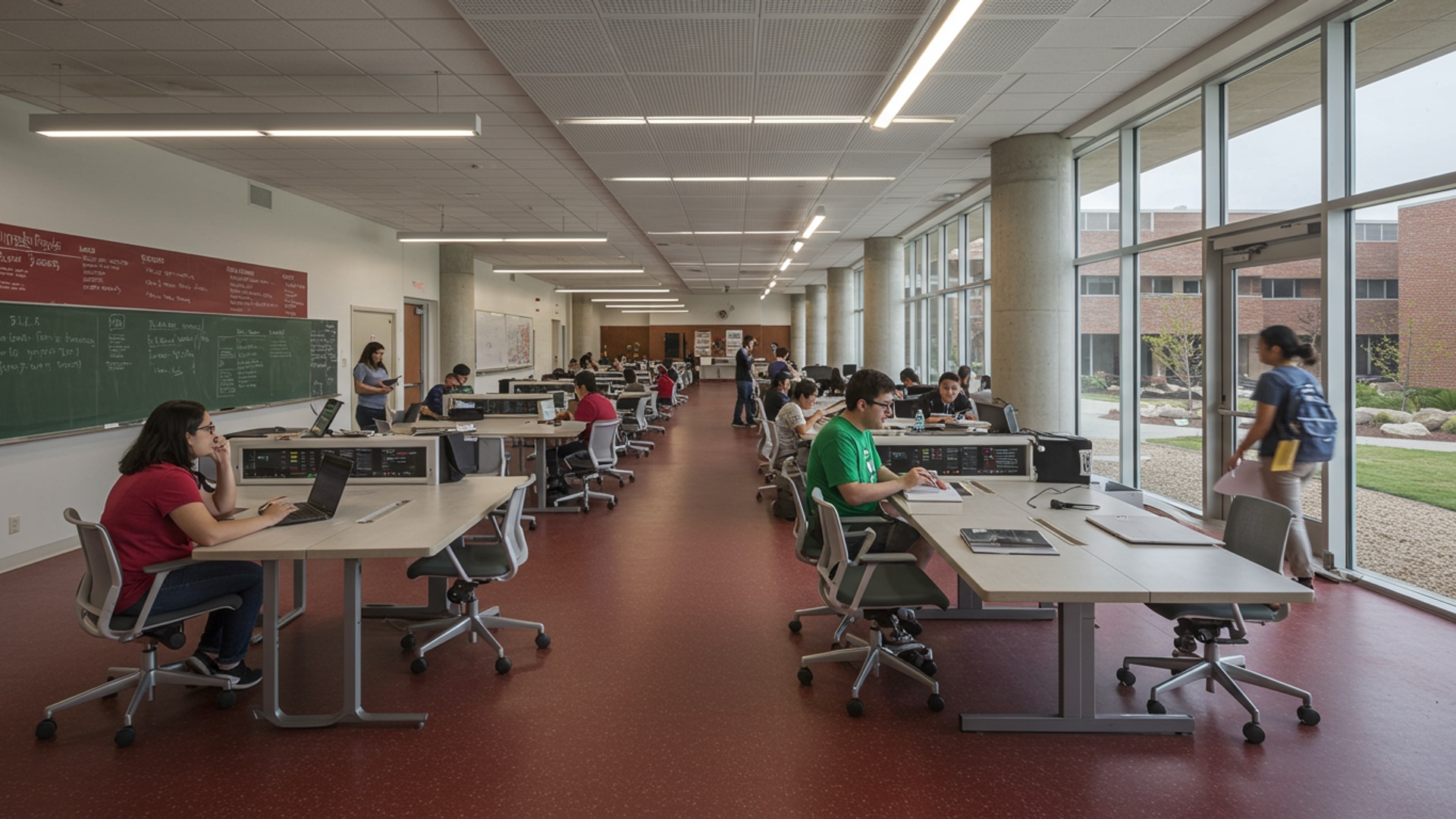Stanford University consistently propels the technological frontier, fostering an unparalleled ecosystem that birthed Silicon Valley giants like Google and Hewlett-Packard. Its pioneering research in artificial intelligence and machine learning, exemplified by advancements in large language models and autonomous systems, directly shapes today’s disruptive innovations. Stanford’s interdisciplinary approach and robust entrepreneurial culture empower graduates to not only secure but actively define future-ready careers, from leading venture-backed AI startups to architecting sustainable tech solutions. This continuous cycle of groundbreaking discovery and real-world application cements Stanford’s pivotal role in shaping the global digital economy and preparing the next generation of innovators.

The Birthplace of Silicon Valley: Stanford’s Enduring Legacy
Ever wondered why a relatively small area in California became the global epicenter of tech innovation? Much of that credit goes to one institution: Stanford University. Nestled in the heart of what we now call Silicon Valley, Stanford’s influence isn’t just about groundbreaking research; it’s about a unique culture that actively encourages students to turn their ideas into world-changing companies. Think of it as a fertile ground where brilliant minds meet resources, mentorship. a fearless attitude towards entrepreneurship.
This isn’t a new phenomenon. As far back as the mid-20th century, figures like Frederick Terman, then Dean of Engineering at Stanford University, actively encouraged his students to start companies right there in the local area. He even helped them secure funding and space. This radical idea – that a university should foster commercial ventures – was a game-changer. It directly led to the founding of companies like Hewlett-Packard (HP) by Stanford alumni Bill Hewlett and David Packard, essentially laying the cornerstone for Silicon Valley as we know it today. This “Stanford model” of research, entrepreneurship. close industry collaboration became the blueprint for modern tech hubs worldwide.
Decoding Tech Innovation and Future-Ready Careers
Before we dive deeper, let’s get clear on what we mean by “tech innovation” and “future-ready careers.”
- Tech Innovation: At its core, this means creating new or significantly improved technologies, products, or services that solve problems, enhance lives, or change the way we interact with the world. It’s not just about inventing something completely new; it can also be about finding a novel way to use existing tech. Think of how smartphones weren’t a brand-new concept. the iPhone innovated on user experience and app ecosystems.
- Future-Ready Careers: These are jobs that are resilient to rapid technological change and automation. They often require skills that machines can’t easily replicate, such as critical thinking, creativity, complex problem-solving, emotional intelligence. adaptability. In the tech world, this means being able to learn new programming languages, grasp emerging trends like AI and blockchain. apply ethical considerations to technology development.
Stanford University understands these concepts deeply, baking them into its curriculum and fostering an environment where students aren’t just taught existing knowledge. challenged to create the knowledge and tools of tomorrow. They’re preparing graduates not just for jobs that exist today. for those that haven’t even been imagined yet.
Stanford’s Entrepreneurial Engine: From Dorm Room to Unicorn
One of the most defining aspects of Stanford University’s impact is its unparalleled entrepreneurial ecosystem. It’s not just about having a great idea; it’s about having the support system to turn that idea into a viable business. Stanford provides this in spades:
- Venture Capital Connections: The proximity to Sand Hill Road, home to many of the world’s leading venture capital firms, means Stanford students and faculty have direct access to funding and investment opportunities. Many VCs actively seek out Stanford-affiliated startups.
- Incubators and Accelerators: Programs like StartX, an independent non-profit startup accelerator for the Stanford community, offer mentorship, resources. connections to help early-stage companies grow. I once spoke to a young entrepreneur who described StartX as “a pressure cooker of brilliance,” where he learned more in three months than he had in two years of traditional business studies.
- Specialized Courses: Stanford offers unique courses like “Lean LaunchPad,” where students learn to develop and validate business models through real-world customer interaction, rather than just theoretical planning. This hands-on approach is crucial.
The list of companies founded by Stanford alumni is staggering, including Google, Yahoo, Netflix, Instagram, LinkedIn. countless others. These aren’t just big names; they’re companies that have fundamentally reshaped industries and daily life. For instance, the founders of Google, Larry Page and Sergey Brin, met at Stanford University while pursuing their PhDs. Their groundbreaking work on search algorithms blossomed from a research project into a global titan.
Pioneering Research: Shaping Tomorrow’s Technologies
Stanford University is a powerhouse of fundamental and applied research, consistently pushing the boundaries of what’s possible. Their labs are often where the seeds of future industries are sown.
- Artificial Intelligence (AI) and Machine Learning (ML): Stanford has long been at the forefront of AI research. Projects like the Stanford Artificial Intelligence Laboratory (SAIL) have contributed immensely to areas like natural language processing, computer vision. robotics. For example, groundbreaking work on neural networks and deep learning, which power everything from facial recognition on your phone to recommendation engines, has deep roots in Stanford research.
- Biotechnology and Healthcare: From developing new drug delivery systems to personalized medicine and advanced medical imaging, Stanford’s Bio-X program fosters interdisciplinary collaboration between engineering, medicine. the sciences to tackle complex health challenges.
- Internet and Computing: Decades ago, Stanford played a key role in the development of ARPANET, the precursor to the internet. Today, research continues in areas like cybersecurity, cloud computing. quantum computing, ensuring the digital backbone of our world remains robust and evolves.
Consider the impact of the Stanford Question Answering Dataset (SQuAD), a reading comprehension dataset that has become a benchmark for training and evaluating AI models. Researchers use datasets like SQuAD to teach machines to grasp text and answer questions, a core component of virtual assistants and sophisticated search engines. This kind of foundational research at Stanford University directly fuels the advancements we see in consumer tech.
Curriculum Designed for a Dynamic Future
What sets Stanford’s education apart is its focus on equipping students with skills that transcend specific technologies, preparing them for a landscape of continuous change. It’s less about memorizing facts and more about learning how to learn, adapt. innovate.
Here’s a look at how a Stanford-style education often compares to more traditional approaches:
| Feature | Traditional Education | Stanford-Approach Education |
|---|---|---|
| Core Focus | Mastering established knowledge and theories. | Problem-solving, critical thinking, innovation. ethical application. |
| Learning Style | Lectures, rote memorization, standardized tests. | Project-based learning, interdisciplinary collaboration, real-world challenges, hands-on experience. |
| Skill Emphasis | Specific technical skills, academic proficiency. | Adaptability, creativity, communication, leadership, ethical reasoning, coding, data literacy. |
| Career Preparation | For existing job roles. | For existing and future, unknown job roles; entrepreneurship. |
Courses often combine technical depth with broader perspectives. For instance, a computer science student might take classes not just in advanced algorithms. also in the ethics of AI, design thinking. even psychology to interpret user behavior. This holistic approach ensures graduates from Stanford University are not just skilled coders or engineers. thoughtful leaders capable of shaping technology responsibly.
The Power of the Stanford Alumni Network: A Global Web of Influence
When you attend Stanford University, you don’t just get an education; you join an incredibly powerful and influential global network. The alumni community is a living testament to Stanford’s impact on tech innovation and future-ready careers. Think of it as a vast, supportive web connecting current students with leaders across every major industry.
- Founders and Leaders: As mentioned, the founders of Google, Yahoo, Netflix, LinkedIn, PayPal, Instagram. countless other tech giants are Stanford alumni. This creates a direct pipeline of mentorship, internship opportunities. even seed funding for new ventures.
- Mentorship Opportunities: Alumni often return to campus to speak, mentor students, or participate in entrepreneurial programs. This direct access to experienced professionals is invaluable. I’ve heard stories of students getting advice on their startup ideas directly from a CEO who founded a multi-billion dollar company – that’s the kind of access Stanford provides.
- Career Pathways: The “Stanford mafia” (a joking term for the strong network) is real. Employers actively seek out Stanford graduates, knowing they come from a rigorous, innovative environment. This network often opens doors to opportunities that might otherwise be inaccessible.
A great example is Kevin Systrom, co-founder of Instagram. He studied at Stanford University, where he gained foundational knowledge and likely connected with early mentors and peers who would become crucial to his entrepreneurial journey. The environment encouraged him to experiment and build, eventually leading to one of the most widely used social media platforms today.
Ethical Innovation: Building Technology Responsibly
As technology becomes more powerful and pervasive, the ethical implications become increasingly critical. Stanford University recognizes this deeply and integrates discussions around ethics, fairness, privacy. social responsibility into its tech education. This focus is vital for future-ready careers because the next generation of tech leaders will need to navigate complex societal challenges posed by AI, big data. automation.
- Ethical AI Programs: Stanford offers programs and research initiatives dedicated to understanding and mitigating bias in AI, ensuring fairness. developing responsible AI practices. This includes examining how algorithms can perpetuate societal inequalities and working to build systems that are transparent and accountable.
- Data Privacy and Security: With massive amounts of personal data being collected, privacy and security are paramount. Stanford researchers are at the forefront of developing secure systems and advocating for policies that protect individual data.
- Human-Centered Design: Emphasizing that technology should serve humanity, not the other way around. This means designing products and services with a deep understanding of human needs, behaviors. potential impacts.
For example, a student developing a new facial recognition system at Stanford University would not only be trained in the technical aspects of machine learning but also rigorously challenged on the potential for misuse, privacy implications. the need for informed consent. This ensures that the innovations are not just technically brilliant. also socially conscious.
Your Path to Impact: Actionable Takeaways for Aspiring Innovators
You don’t need to attend Stanford University to develop a future-ready mindset or make a significant impact in tech. The core principles that drive Stanford’s success are accessible to anyone with curiosity and dedication. Here are some actionable takeaways for you, whether you’re a teen or a young adult:
- Cultivate a Problem-Solving Mindset: Look around you. What problems do you see? How could technology offer a solution? Start small. Can you automate a tedious task at home or school?
- Learn to Code (Even Just a Little): Coding is the language of innovation. Start with free online resources like Codecademy, Khan Academy, or freeCodeCamp. Python is a great beginner-friendly language. Try building a simple website, a small game, or a data analysis script. Even a basic understanding helps you think computationally.
# Simple Python example: A basic "Hello, World!" program print("Hello, aspiring innovator!") # A simple loop to count for i in range(1, 6): print(f"Count: {i}") - Embrace Interdisciplinary Learning: Don’t just stick to one subject. If you love tech, also explore psychology, design, ethics, or economics. The most innovative solutions often come from combining different fields.
- Build Things, Even if They Fail: The best way to learn is by doing. Start a side project. Join a hackathon (online or in-person). Don’t be afraid to experiment, make mistakes. learn from them. Every failure is a stepping stone to success.
- Network and Connect: Join online communities, attend virtual meetups, or participate in local tech clubs. Learn from others, share your ideas. find mentors.
- Stay Curious and Adaptable: The tech landscape changes constantly. Commit to lifelong learning. Read tech news, follow thought leaders. always be open to new ideas and technologies.
- Think Ethically: As you learn and create, always consider the broader impact of technology on people and society. How can your innovations be used for good? How can you prevent potential harm?
Conclusion
Stanford University’s indelible mark on tech innovation, from pioneering Silicon Valley with Hewlett-Packard to spearheading today’s AI revolution and sustainable tech, underscores its unique ecosystem. It cultivates future-ready careers not just through academic rigor. by fostering an entrepreneurial spirit deeply intertwined with venture capital and cutting-edge interdisciplinary research. This isn’t merely about obtaining a degree; it’s about immersing oneself in an environment where bold ideas rapidly transform into impactful ventures, as seen in recent advancements in personalized medicine and climate solutions originating from its labs. To truly thrive in this dynamic landscape, my personal tip is to actively cultivate a “builder’s mindset.” Don’t just consume knowledge; seek out collaborative projects, connect with mentors across diverse fields. embrace iteration as a core principle. Reflecting on Stanford’s continuous evolution, it’s clear that adaptability and a relentless pursuit of solving real-world problems are paramount. Therefore, I urge you to embrace curiosity, challenge conventions. actively shape your own innovative path. The future of tech innovation and your pivotal role within it begins with your proactive engagement today.
More Articles
Silicon Valley’s Core: Stanford University’s Role in Driving Tech Innovation Forward
Beyond the Ivy Gates: Exploring Harvard University’s Impact on Global Innovation 2025
Unlock Your Future: Discover Columbia University’s Top Programs for Innovators in 2025
Navigating Your MBA Journey: Choosing the Right Specialization for Future Success
FAQs
So, how exactly has Stanford shaped the tech world, especially Silicon Valley?
Stanford’s influence is huge! It’s been a key player since the early days, fostering a culture of innovation and entrepreneurship. Many professors and alumni have gone on to found or lead groundbreaking tech companies, essentially creating the backbone of Silicon Valley. Think about the direct connection between research, talent. funding that originated there.
What are some famous tech companies started by Stanford folks?
Oh, there’s a long list! Google, Yahoo, Hewlett-Packard (HP), Cisco, LinkedIn, Sun Microsystems, Netflix. Instagram are just a few of the giants that trace their roots back to Stanford alumni. It really highlights the entrepreneurial spirit nurtured at the university.
How does Stanford get students ready for tomorrow’s tech jobs?
Stanford focuses on a blend of deep theoretical knowledge and hands-on experience. They offer cutting-edge courses in AI, machine learning, data science. cybersecurity, often taught by leaders in those fields. Plus, there’s a strong emphasis on interdisciplinary learning, problem-solving. critical thinking, which are essential for adapting to a rapidly changing tech landscape.
Are there particular areas of research at Stanford that are really pushing tech forward?
Absolutely. Stanford is at the forefront of research in artificial intelligence, robotics, biotech, sustainable energy technologies. advanced computing. Their research labs often collaborate with industry, leading to breakthroughs that frequently transition into real-world applications and new companies.
What makes a Stanford education so good for a tech career?
Beyond the top-tier academics, it’s the ecosystem. Students get access to world-renowned faculty, state-of-the-art research facilities. a powerful alumni network. There are also tons of opportunities for internships, startup incubation. mentorship right in the heart of Silicon Valley, giving them a massive head start.
Does Stanford help students who want to start their own tech companies?
Definitely! Stanford has a robust entrepreneurial ecosystem. Programs like StartX, the Stanford Technology Ventures Program (STVP). various incubators provide mentorship, resources. funding opportunities for student startups. Many courses even encourage developing business ideas alongside technical projects.
How does Stanford keep up with all the fast changes in technology?
Stanford is constantly evolving its curriculum and research focus. Faculty members are often active researchers and industry consultants, bringing the latest developments directly into the classroom. The university also encourages interdisciplinary collaboration and invests heavily in cutting-edge research facilities, ensuring it stays at the vanguard of technological progress.



